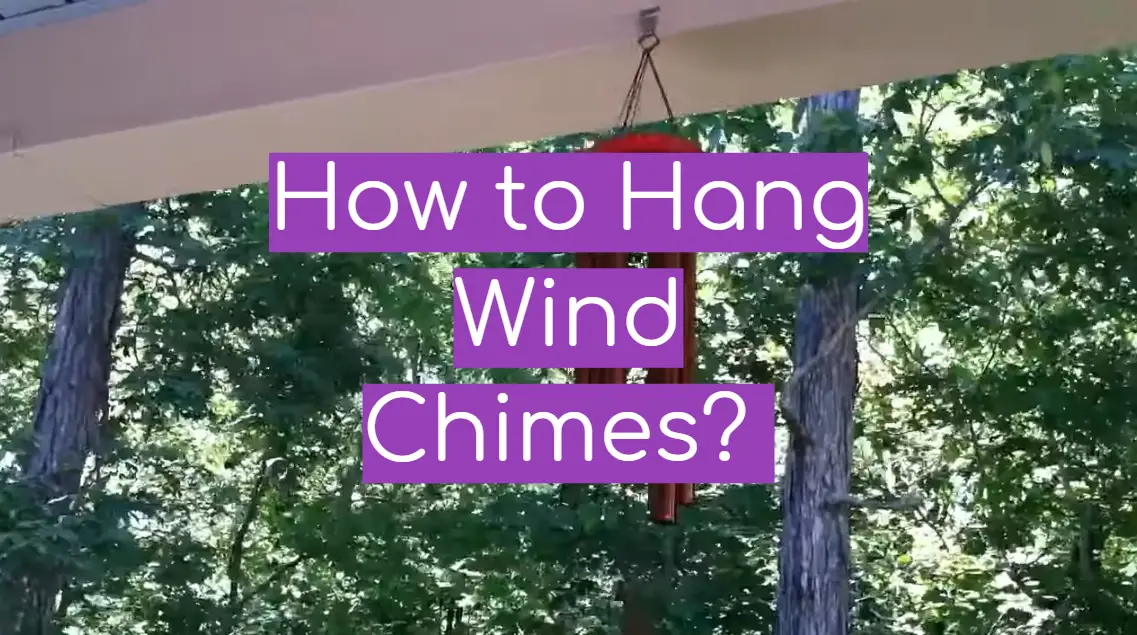Wind chimes are a wonderful way to bring a sense of calm into your house or garden. You may hang them from the ceiling or a wall with the correct mounting equipment. If you don’t want to poke holes in anything, you may use apply a lantern holder or hang the chimes from a tree outdoors.
The step-by-step guide for hanging a wind chime from a ceiling:
Always pick a windy location to let the chimes sound
Wind chimes, as its name implies, need wind to chime. Wind-exposed porches or patios are ideal for hanging wind chimes. You may also hang them near your front/back door to provoke them as you pass by. Place it away from a bedroom, where the chiming can keep someone awake at night. You may also hang them inside, but you’ll have to touch them in order to hear them chime.
Drill a hole with a drill instrument and pilot point bit
To begin, place a pilot point bit in a drill with a small diameter than the hook. Then, at the spot where you wish to hang the hook, drill a tiny hole. Make a hole that is approximately 2 to 3 inches deep. If you’re hanging the chime from a ceiling, you may need to use a stepladder.
The pointed end of the ceiling hook should be twisted clockwise
With the hanger, grab the hook by the end and place the pointy edge into the pilot hole you’ve drilled. Then, when it’s secure in the hole, spin it clockwise. If the hook screw is lengthier than the depth of the pilot hole you drilled, you may need to apply extra pressure when making the final twists.
Loop the chime chain onto the hook
Hook the chain of the wind chime onto the hook at the chosen length. Tie a robust loop at the string’s end to use as a hook if you constructed DIY wind chime using a string instead of a chain. Hook the final chain link onto the hook if you want the chime to hang lower. Select a chain length that is around the middle or start of the chain to hang it higher.
Other ways to hang a DIY wind chime:
- Glue a J-hook onto a ceiling. You may buy sticky hooks created especially for hanging plants and other goods from ceilings if you don’t want to drill a hole in the ceiling. Check that the chime does not exceed the package’s maximum weight restriction. Simply peel off the protecting strips from the adhesive mount and attach them to the surface to be hung. To achieve a solid hold, add pressure to the stuck-on mount for one minute. Consult the package’s directions;
- A plant-hanging bracket can be mounted to a vertical wall. Attach a plant-hanging bracket to any vertical wall using a hammer and nails or a drill and screws. Connect the wind chime to the bracket by wrapping a chain link onto the hook. Make sure the bracket’s hanging portion sticks out far enough so the wind chime can swing back and forth without striking the wall;
- Use a plant holder or tall lantern. A tall lamp or plant holder may be used to hang the wind chime. If you need to move the chime about, a plant holder or tall lantern can be a perfect option. A holder that is at least 4 to 5 feet tall is preferable, although a smaller wind chime might be held in a shorter one;
- A durable rope for hanging a wind chime from a tree branch. Simply thread a rope through a chain link and attach it to a tree if you need a chime to hang outside. Choose a horizontal branch that is quite low to the ground. One with a tiny dip so the chime doesn’t slide down the branch is ideal. Wrap the area of the rope that comes into touch with the tree with a bandana, sock, or other material to minimize rope friction from hurting the tree. A tube of garden hose material may also be used as a cushion;
Table of Contents
Different hooks for hanging wind chimes
Pointed rods at the bottom of long hooks and hangers, such as a shepherd’s hook, secure the device. Some are large enough to hold large hanging baskets, making them ideal for wind chimes:
Deck hooks
Deck hooks are specialty hangers that are used to hang items from a deck’s railing. Many of them are clamped in place to prevent the rail from being damaged. These hooks come in a number of styles, including 2 shepherd’s hooks along with an extension arm that swings back inside.
Wall-mounted brackets and hooks
A robust device designed to hold a hanging basket a few inches away from a structure is a wall-mounted plant hook, also called a bracket. They may also be used to hang chimes or bird feeders, and they’re often screwed to the side of a building or wooden post.
Calculate the width and length of the chimes, as you would with other hooks, to ensure that they will have enough area to move freely when strung, and choose a hook that is the farthest away from the anchoring screws compared to other hooks.
Because this version is wall-mounted, you can place the hook as high as you like up a wall or post to enable the chimes to blow in the wind without hitting the ground. If the chimes are entirely exposed to the elements during bad weather, they should be taken down; otherwise, they will smash on the building closest to them.
In-ground plant hooks
Tall hooks and hangers, e.g. a shepherd’s hook, are good heavy-duty chime hangers because they feature pointed rods at the bottom to fix the device in the ground. Some are made to hold even the heaviest of hanging baskets, making them ideal for wind chimes. These in-ground holders usually contain one or two hooks, allowing for the hanging of one or two objects at a time.
While most wind chimes will fit on these hooks since they’re broad and high enough off the ground, measure your chimes beforehand to ensure they’ll be able to swing smoothly without contacting the post or the ground. During heavy winds or severe weather, you may want to take the chimes down, since they may knock against the hook post, be tangled, or even get broken.
Ceiling hooks
Another option for hanging big chimes is to use a ceiling hook installed into the ceiling of a porch, sunroom, or the overhang of a doorway. These hooks range in style from simple metal hooks to more intricate decorative hooks. Some types screw into a ceiling or beam directly, while others are built to support high weights with ceiling anchors to prevent ceiling damage.
Unless the chimes are constructed of heavy materials, the load rating for ceiling hooks is mentioned on their package. In most circumstances, even a lightweight hook is sturdy enough for chimes. To keep the chimes from falling off in heavy winds or during an earthquake, choose a hook that clamps over the top.
What strings are required for hanging wind chimes?
Fishing line (nylon)
The fact that the fishing line is a multi-purpose string is not surprising at all. This clear nylon thread is sturdy, flexible, and simple to work with. Because it is translucent, it is ideal for any sort of chimes in any theme, since there is no need to worry about colors clashing. Also, the fishing line is recognized for being simple to tie and, more importantly, strong knots. It is offered in many weights and may provide a sturdy foundation for each component of your chime.
Waxed and braided cord
There’s only one thing that’s stronger than a single string of thread, and that’s when there’s a bunch of them. Because of this, a braided cable is an excellent choice for wind chimes. Polyester or nylon are often utilized for this sort of rope. In most situations, a waxed coat is applied to the thread to increase its life and provide a waterproof covering. It comes in a variety of colors, and the spools are reasonably priced.
The fishing line or braided cable are the finest types of string for building and mending wind chimes. Both of the strings are robust, long-lasting, and flexible enough to tie knots that are very tight. The finer the line, the fewer people will see it. A thicker line, on the other hand, will be robust and able to hold greater weight.
Where is it possible to hang wind chimes inside your house?
If you want to follow the Feng Shui philosophy, then it is important to find the proper location for your wind chime before placing it in a bedroom. Mostly, the placement depends on the material used for making a chime:
Metal chimes
A metal chime is typically considered an excellent investment for your house or workplace. With their soothing metal sound, they minimize or slow down the bad energy in your building. Aluminum, silver, copper, brass, and bronze may be used to make metal chimes that provide a pleasant and cheerful sound. Metal chimes are known for removing any bad energy or power from any house.
In the north, west, or northwestern zone, a metal chime should be placed. When you hang these chimes in the west direction, it brings good luck to the family and also assists family members in bringing honor into their life.
Wooden/bamboo chimes
When the wind hits the bamboo rods of a chime, they make a pleasant clatter. These bamboo wind chimes bounce harmful and negative energy away, creating a quiet and good energy-filled atmosphere. When a bamboo chime is installed in the home, it provides a feeling of security. Bamboo chimes are an excellent option for a child’s room since they provide a relaxing and calming sound. Bamboo chimes may also be used to decorate the exterior of your home or at the front door.
Related Article: How to make bamboo wind chimes
A wooden chime should be placed in your home’s southeastern, eastern, or southern zones. The southeast and east directions are known to be tied to trees and create a significant quantity of wood energy. As a result, placing your wooden or bamboo wind chime towards the southeast or east direction of the house is always a good idea.
Ceramic chimes
Ceramic wind chimes, sometimes called pottery chimes, are composed mostly of ceramic, glass, or pottery. Such chimes may be used as a showcase or an antique element in your home. In the home, a ceramic chime delivers luck in the areas of love and romance, wisdom, and health. Ceramic wind chimes come in a variety of designs and are very inexpensive. You may look for ceramic wind chimes on several websites and order wind chimes from them.
Your ceramic wind chime should be placed in the west, northwest, southwest, and northeast corners of your home. If you place ceramic chimes in the northeast, they will bring you wisdom and luck, if you put them in the southwest, romance will flourish, and if you put them in the middle, your health will improve.
Where should you place large chimes?
Large chimes can be louder than smaller or medium-sized versions. Install the chimes in a location where they will get some wind but won’t irritate your neighbors or anybody else in your house. While standing near your house, have a buddy hold and jiggle the chimes in different spots you’d want them to be.
The sound may be reduced in certain areas, such as among thick plants or ancient trees, or an alleyway, depending on location. If you want them to chime louder, make sure they will be affected by airflow if you put them in a semi-enclosed place like a porch.
Comparison of Indicators for Hanging Wind Chimes
When it comes to hanging wind chimes, there are a variety of factors to consider. In this table, we will compare various indicators for hanging wind chimes, including the ideal height for hanging, the number of chimes, and the recommended material for hanging.
| Indicator | Ideal Measurement | Description |
|---|---|---|
| Height | 6-8 feet | The wind chimes should be hung at a height of 6-8 feet above the ground to ensure they are easily heard and not a tripping hazard. |
| Number of chimes | 5-8 | The ideal number of chimes is between 5 and 8, as this creates a pleasant and soothing sound without being overwhelming. |
| Material for hanging | Sturdy Metal or Nylon cord | Wind chimes should be hung with a sturdy metal or nylon cord to ensure they can withstand wind and weather conditions without breaking or deteriorating quickly. |
Hanging wind chimes requires careful consideration of various factors to ensure the best sound quality and longevity of the chimes. The ideal height for hanging wind chimes is 6-8 feet, the ideal number of chimes is between 5 and 8, and a sturdy metal or nylon cord should be used to hang the chimes.
FAQ
How should you hang a regular wind chime from a supermarket?
The connected or enclosed O-ring or hook may be used to hang it. If you attach a wire or string to the O-ring to suspend the chimes lower, the balance may be thrown off. The chime becomes unstable and jangly because of this.
Is it possible to hang a wind chime on the siding?
Mark the location where you want the wind chimes to be hung on the siding wall of the house. Using a stepladder, reach the designated place and drill a hole in it. To thread, place a hook in the sketched hole and spin it clockwise. To make the hook hang properly on the thread, keep the thread straight when attaching the hook to it. Pick the chimes and attach the loop at the top of the chimes to the hook after the hook has been mentioned.
How can you hang a heavy wind chime?
If you need to hang a chime inside the room, use a durable ceiling hook and place it by a window. If you need to place it outside, try using a shepherd hook.
How to hang a large chime from a tree outside?
The majority of huge wind chimes may be hung on the thick branches of an old tree, far from the trunk. The branches will swing left, right, up, and down – the chimes will produce nice melodies. Not to mention how awesome they may look in motion.
What tools do you need to hang wind chimes?
To hang wind chimes, you will need a few basic tools such as a drill, drill bit, screws, a screwdriver, a hammer, a level, and a measuring tape. You may also need additional hardware depending on the type of surface you are hanging the wind chime from.
Where should you hang wind chimes for the best sound?
To get the best sound from your wind chimes, you should hang them in an open area where there is a light breeze. Ideally, wind chimes should be hung at least six feet off the ground and away from any walls or obstructions that could interfere with the sound.
How do you hang wind chimes from a ceiling?
To hang wind chimes from a ceiling, you will need a ceiling hook. Use a drill to create a pilot hole in the ceiling, then screw in the ceiling hook. Make sure the hook is screwed in securely and can support the weight of the wind chimes.
How do you hang wind chimes from a porch or patio?
To hang wind chimes from a porch or patio, you can use a hook or a bracket. If you are using a hook, drill a pilot hole into the ceiling or beam where you want to hang the wind chimes. Screw the hook into place and hang the wind chimes from the hook. If you are using a bracket, mount the bracket onto the wall or beam using screws, then hang the wind chimes from the bracket.
Can wind chimes be hung from a window?
Yes, wind chimes can be hung from a window, but it is important to use suction cups specifically designed for hanging items from windows. Make sure the suction cups are strong enough to support the weight of the wind chimes and test them before hanging the wind chimes.
How do you hang wind chimes from a shepherd’s hook?
To hang wind chimes from a shepherd’s hook, simply hang the wind chimes from the hook. Make sure the hook is secured in the ground and can support the weight of the wind chimes. You may also want to add a weight to the bottom of the wind chimes to keep them from moving too much in the wind.
How do you hang wind chimes from a brick wall?
To hang wind chimes from a brick wall, you will need a masonry drill bit, screws, and wall anchors. Use the drill bit to create pilot holes in the brick where you want to hang the wind chimes. Insert wall anchors into the pilot holes, then screw in the screws. Hang the wind chimes from the screws.
Can you hang wind chimes from a tree branch?
Yes, wind chimes can be hung from a tree branch using a hook or a string. If you are using a hook, make sure it is securely fastened to the tree branch and can support the weight of the wind chimes. If you are using a string, tie a knot around the tree branch and then tie the wind chimes to the other end of the string.
How do you hang wind chimes from a metal pole?
To hang wind chimes from a metal pole, you can use a metal hook or a metal bracket. If you are using a hook, make sure it is securely fastened to the pole and can support the weight of the wind chimes. If you are using a bracket, mount the bracket onto the pole using screws, then hang the wind chimes from the bracket.
Final Words
Hanging wind chimes is a relatively simple task that can bring a lot of joy and beauty to your yard or other outdoor space. With the right tools and some creative inspiration, you can create a tranquil sanctuary that speaks to your personality. Remember to hang wind chimes in an area where they will be exposed to the wind for maximum effect. Choose materials carefully so your wind chimes will last for many years to come.






Leave a Reply